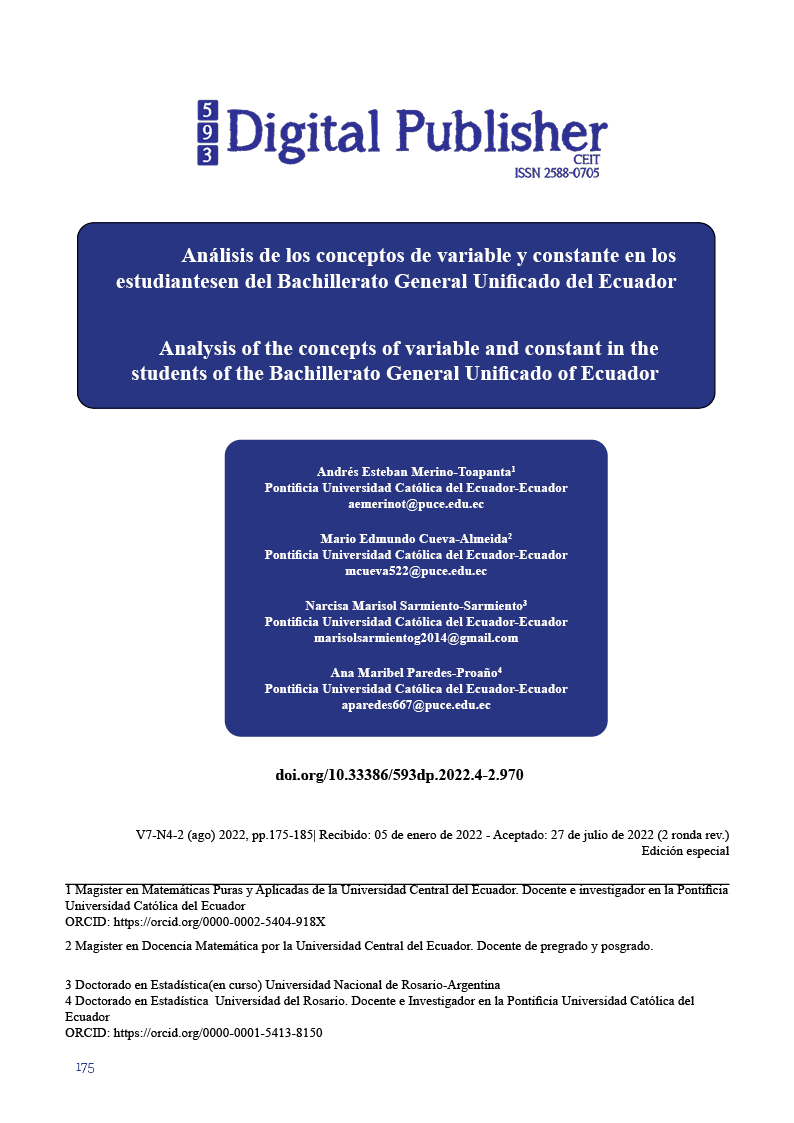Analysis of the concepts of variable and constant in the students of the Bachillerato General Unificado of Ecuador
Main Article Content
Abstract
In this paper, we study about the concept that students have of the mathematical terms: variable and constant. For this, a questionnaire was applied to 494 students of the first undergraduate semester of the Pontificia Universidad Católica del Ecuador; this served to determine which are the words most used by students to present these concepts; furthermore, these definitions were analyzed to measure their level of formality and contextualize the concept according to three fundamental uses: function, algebraic expression, and equation. On the other hand, 12 official texts of Mathematics of Basic General Education (EGB) and Unified General Baccalaureate (BGU) of the Ministry of Education of Ecuador were reviewed, used between 2016 and 2019 to analyze the concept of variable and determine the context in which is employs.
Downloads
Article Details

This work is licensed under a Creative Commons Attribution-NonCommercial-ShareAlike 4.0 International License.
1. Derechos de autor
Las obras que se publican en 593 Digital Publisher CEIT están sujetas a los siguientes términos:
1.1. 593 Digital Publisher CEIT, conserva los derechos patrimoniales (copyright) de las obras publicadas, favorece y permite la reutilización de las mismas bajo la licencia Licencia Creative Commons 4.0 de Reconocimiento-NoComercial-CompartirIgual 4.0, por lo cual se pueden copiar, usar, difundir, transmitir y exponer públicamente, siempre que:
1.1.a. Se cite la autoría y fuente original de su publicación (revista, editorial, URL).
1.1.b. No se usen para fines comerciales u onerosos.
1.1.c. Se mencione la existencia y especificaciones de esta licencia de uso.
References
Azcárate, C. & Camacho, M. (2003). Sobre la Investigación en Didáctica del Análisis Matemático. Boletín de la Asociación Matemática Venezolana, 10(2): 135-150.
Escudero, I., Gavilán, M. & Sánchez, G. (2014). Una aproximación a los cambios en el discurso matemático generado en el proceso de definir. Revista Latinoamericana de Investigación en Matemática Educativa, 17(1):7–32.
INEVAL (2019). Instituto Nacional de Evaluación Educativa. Obtenido de evaluaciones.gob.ec: http://evaluaciones.evaluacion.gob.ec/BI/nacional/
Font, V. & Godino, J. (2006). La noción de configuración epistémica como herramienta de análisis de textos matemáticos: su uso en la formación de profesores. Educação Matemática Pesquisa, 8(1): 67-98.
Mendelson, E. (2015). Introduction to mathematical logic. CRC Press, 6 edición.
ONU (2018). La agenda 2030 y los objetivos del desarrollo sostenible. Una oportunidad para américa latina. Obtenido de cepal.org: https://repositorio.cepal.org/bitstream/handle/11362/40155/24/S1801141_es.pdf
Pinter, C. (2014). A book of set theory. Dover Publications, Inc.
Real Academia Española (2001). Diccionario de la lengua española. Dover Publications, Inc., 22 edición. Consultado en http://www.rae.es/rae.html.
Standaert, R. (2011). Aprender a Enseñar: Una introducción a la didáctica general. Quitio: ASOCIACIÓN FLAMENCA DE COOPERACIÓN AL DESARROLLO Y ASISTENCIA TÉCNICA, VVOB - ECUADOR.
Stewart, J. (2012). Cálculo de una variable: trascendentes tempranas. Cengage Learning, 2 edición.
Stewart, J., Redlin, L. & Watson, S. (2012). Precálculo matemáticas para el cálculo. Cengage, 6 edición.
INEVAL. (2019). Instituto Nacional de Evaluación Educativa. Obtenido de evaluaciones.gob.ec: http://evaluaciones.evaluacion.gob.ec/BI/nacional/
ONU. (2018). La agenda 2030 y los objetivos del desarrollo sostenible. Una oportunidad para américa latina. Obtenido de cepal.org: https://repositorio.cepal.org/bitstream/handle/11362/40155/24/S1801141_es.pdf
Standaert, R. (2011). Aprender a Enseñar: Una introducción a la didáctica general. Quitio: ASOCIACIÓN FLAMENCA DE COOPERACIÓN AL DESARROLLO Y ASISTENCIA TÉCNICA, VVOB - ECUADOR.
Suárez, M. (2019). Libro de texto, práctica educativa y competencia comunicativa. Polyphonía: Revista de Educación Inclusiva, 26-45.
Trigueros, M., Ursini, S. & Lozano, D. (2000). La conceptualización de la variable en la enseñanza media. Educación Matemática, 12(2):27–48.
Vinner, S. (1991). The Role of Definitions in the Teaching and Learning of Mathematics. Springer Netherlands, Dordrecht.
Winicki, G. (2006). Las definiciones en matemáticas y los procesos de su formulación: algunas reflexiones. Acta Latinoamericana de Matemática Educativa, 19:528–537.





